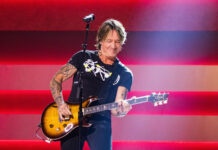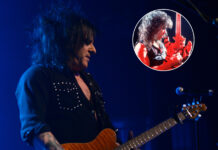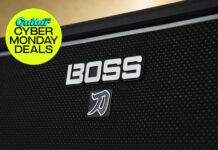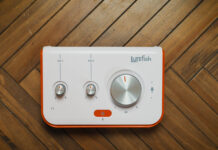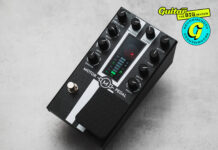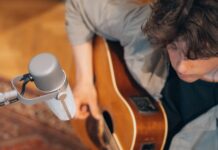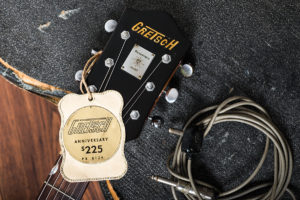
The History of Gretsch Anniversary Models
As Gretsch Guitars celebrates its 135th anniversary in style, Dave Hunter charts the history of one of the company’s most famous electric date-markers – the Anniversary model.
The price tag of the original Gretsch Anniversary model was one of the big draws when it was launched
Many guitar companies now make anniversary models to celebrate milestones and special occasions, but most of these ‘celebration guitars’ are limited-run designs. The Gretsch Anniversary, however, quickly became a mainstay of the company’s line-up when it debuted in the late 50s. Yet arguably more significant than its popularity at the time of issue is the way the Anniversary has held on as an enduring route to vintage Gretsch goodness, providing a relatively easy means for enthusiasts of the 21st century to lay their hands on the ‘real thing’ without digging too deeply into their pockets.
Unlike your typical limited edition or special release, the Anniversary models – introduced in 1958 to celebrate Gretsch’s 75th anniversary – were priced at a level intended to bring as many customers as possible in on the celebration. Clearly the effort worked. Gretsch saw no reason to delete the model from the catalogue, and it evolved right alongside its siblings as this rather quirky company changed specs and components over the years, even as the brand’s 100th anniversary eventually faded in the rear-view mirror.
Upon their arrival in ’58, the Anniversary models were constructed the same as the cornerstone hollowbody models such as the 6120 Chet Atkins. Both had hollow bodies that were 16 inches wide and 2.5 inches deep, made from braced laminated maple, with dual f-holes and rounded cutaways. Likewise, their necks had ebony fingerboards, and they were made to the shorter traditional 24.5-inch Gretsch scale length. The Single Anniversary had one Filter’Tron humbucking pickup in the neck position, a tone switch, and a single volume control on the rounded body ‘horn’.
A series of spec sheets for the Gretsch Anniversary models taken from various catalogues in the 1960s
Double Fun
The Double Anniversary got its name from its two Filter’Tron pickups, and also added a three-way selector switch beside the tone switch on the upper bout, plus an individual volume control for each pickup in addition to the final master volume on the horn. Each was available in a sort of vintage sunburst finish that Gretsch called ‘Shade’, or a stylish ‘Two-Tone’, which had a light ‘Smoke Green’ on the top and contrasting darker green on the back and neck. Although the model numbers were generally less referred to than that of the eponymous 6120, the Anniversaries had theirs too: 6124 for the Single in sunburst and 6125 in Two-Tone, 6117 for the Double in sunburst and 6118 in Two-Tone.
Otherwise, what did the 6120 Chet Atkins Hollowbody of ’58 and ’58 have that the Double Anniversary lacked? A bound neck and headstock, bound f-holes, and a Bigsby – and that was about it. Oh, and Chet Atkins’s name on the pickguard. Those were clearly a draw for plenty of players, but at $475 for the 6120 compared to $310 for the Double Anniversary, well, you can see why so many players snatched up the latter.
The Double Anniversary’s bargain status circa 1958 to ’59 translates to more affordable prices on today’s vintage market when compared to a 6120 of the same period, and in similar condition. A quick survey of a few dealers – not the least bit scientific, mind you – confirms that a good 6120 from that time will easily fetch £7,500 or more, while a Double Anniversary can be had for half that, or even significantly less.
The Single Anniversary’s specifications have made that model, however, far less appealing. Arguably the largest component of ‘That Great Gretsch Sound’ comes from the meaty twang of that Filter’Tron in the bridge position, and the Single Annie simply ain’t got one. There are plenty of them out there, so clearly there was no shortage of players eager to take advantage of the bargain $225 price back in the day. Carry that forward to 2018, and it’s not hard to find a vintage Single for somewhere in the region of half the price of the Double.
Of course, the keen-eyed and player-minded among us immediately see another form of bargain in that: grab an affordable Single Anniversary, add a Filter’Tron in the bridge position and a couple more knobs, and you’ve got a pretty reasonably priced 6120-alike, if it’s a player’s guitar you’re after in the first place. Not that we whole-heartedly recommend this route: such modification requires careful consideration of the potential devaluation of an original vintage guitar, weighed alongside the expense of having such work done professionally.Brilliant Highs
In 1960 Gretsch introduced its own in-house single-coil pickup, the Hilo’Tron, to replace the Model 200 (aka Dynasonic) they had previously been buying in from DeArmond. The new pickup looked something like a Filter’Tron with only one row of six adjustable pole pieces showing, protected by what was essentially a Filter’Tron cover with its centre band chopped down. But beneath the top plate lurked just one lightly-wound coil, positioned off to one side of the structure, with a magnet attached to it side-on.
The company was obviously quite pleased with the new units, and presented dealers and customers with a brochure entirely dedicated to these components. Referred to as “electronic guitar heads” in Gretsch parlance, the Hilo’Trons were touted as being ‘Full Hi-Fidelity,’ with ‘Brilliant Highs,’ ‘Mellow Lows,’ and an ‘Extra Lively Response.’ What more could you want from a guitar pickup? That same year, both Anniversary models lost their Filter’Tron humbuckers and trestle bracing, and gained these new Gretsch-made single coil units instead.
In hindsight, it’s hard to see the move as anything other than a downgrading of the model. Filter’Trons are the king of all Gretsch pickups, and players who prefer single-coils generally rave about the DeArmonds of the 50s. For all that, though, an original Hilo’Tron in good condition, on a guitar that’s set up right and playing well, can still sound extremely good through a quality amplifier. They are bright pickups, though, with a little girth and bite in their original form, sure, but not much punching power. These were pretty lightly wound pickups, with resistance readings in the upper 2k ohms to lower or mid 3k ohms range, so they don’t have the ability to push a tube amp very hard on their own, but they do retain the clarity and sparkle that were major sonic objectives for Gretsch at the time.Down Market
The change to Hilo’Trons demarcates the start of a far less-desirable era of Anniversary production in the eyes of players and collectors today, although the model remained quite popular throughout the early 60s. Likely it was still seen as a great bargain in a genuine Gretsch electric guitar – and a good looking one at that – in an age when most players likely weren’t as spec-conscious as we are today. As a result, a ’60 Double Anniversary with Hilo’Trons is almost always significantly cheaper on the vintage market than a ’59 with Filter’Trons (all else being equal), and the discounting might extend to as much as half the value of the latter. Once again, this makes these potentially good value for the vintage Gretsch fan who digs the Hilo’Tron sound, or for someone with the stomach for modding one to ’58/’59 specs.
Later in 1960 Gretsch further confirmed the Anniversary’s second-class status by using rosewood fingerboards rather than ebony. Hilo’Trons and rosewood ’boards don’t appear to have arrived simultaneously, and you will find some crossover in these changes, but by part way into ’61 the new specs seem to have solidified.
One new development the Anniversary didn’t get which the 6120 had received the year before was the ‘zero fret’, the fret added adjacent the nut in the so-called ‘zero’ position to enable a low action determined by overall fret height.
Lauded as an ‘advancement’ in some guitar circles at the time, and still a hotly debated specification, the zero fret was seen as a bonus for Gretsch’s upmarket models – even though, again, many players and collectors today demarcate the ‘pre-zero fret’ years of the 50s as the golden age at Gretsch – and apparently the lower-priced Anniversary models weren’t deemed worthy of the addition. For those who never got on with a zero-fret, this fact can make the ’60 and early ’61 Double Anniversary a desirable acquisition, especially if you can find a transitional example that retains the ebony fingerboard.Living Stereo
In 1961 Gretsch inducted the Anniversary model into another ill-conceived club, which already had several other more high-end models as members. Stereo was the watchword in just about any realm of consumer electronics in the late 50s, and if hi-fi systems were all at it, well, many guitar makers also figured stereo must be the way forward for them, too. Gretsch’s exalted White Falcon and Country Club models had offered a stereo option since ’58, using two more closely-spaced Filter’Tron pickups that had only two rows of three pole pieces under the bass strings in the neck position, and two rows of three under the treble strings in the second pickup nearer the middle position. The output routed one pickup to one amp and the other to a second, and voila, stereo!
It seems, however, that just about the time Gretsch was trying the same trick in ’61 with two three-pole Hilo’Trons on the Sunburst model 6111 and Two-Tone 6112, the guitar world et al was catching on to the reality that you didn’t necessarily get a better sound with bass and treble strings routed independently. That, and the two amps needed to fully achieve the sound (or single, more complex, more expensive ‘stereo amp’) were a further pain in the backside besides. After ’62 the Stereo Anniversary disappeared from the catalogue.
One thing the Anniversary didn’t get in ’61, however, was the double-cutaway body shape given the 6120 and other key models. Again, the Anniversary’s bargain-rate status probably saved it from that ‘advancement’ in guitar design. But what might have been seen in the day as lagging behind the trends helped it remain a more 50s-styled model that continues to this day to please fans of the seminal single-cutaway format that graced guitars in the hands of Eddie Cochran, Duane Eddy, and others.
And yet another thing the Anniversary never got: the clunky mute device that high-end models received in ’61, along with the arguably rather ugly snap-on pad covering the access hole in the back of the guitar’s body. More players removed the pointless, rattling, weight-increasing mute mechanisms from their 6120s, Country Gentlemen, Country Clubs and others than we can begin to count, so it’s another plus that the Anniversary never suffered one.
In ’63 the Double Anniversary was given a bound fingerboard, an upgrade that made it an even better budget route to full-bore Gretschitude… other than the fact that the bindings on Gretsches this age of any status have likely crumbled by now. Still, it was a sign of respect. Also that year, Gretsch introduced the hip new alternative finish ‘Two-Tone Tan’ was introduced, with Bamboo Ivory on the top and Jaguar Tan on the back, sides and neck – all of which sound a lot more appealing than if they’d called it ‘beige-and-brown’.
A 1960 Single Anniversary model complete with Hilo’Tron pickup
Baldwin Beckons
Not much befell the Anniversary models through the mid 60s until Baldwin bought out Gretsch in 1967. Shortly thereafter the Two-Tone (aka Smoke Green) finish option was dropped. The rather pointless Single Anniversary was also unceremoniously deleted during the Baldwin years. The Double Anniversary received the zero fret in ’68.
Gretsch itself underwent several upheavals under Baldwin’s rein, as the big piano company sought to consolidate production and sales operations during what was becoming a downturn for the guitar market in general. In 1970 Baldwin moved guitar-making operations from the Brooklyn plant where Gretsch guitars had been manufactured for 54 years to an existing Baldwin facility in Booneville, Arkansas. The sales team lingered on in Brooklyn for a couple of years, then shifted briefly to Chicago before settling in with Baldwin’s corporate headquarters in Cincinnati, Ohio, in 1972. Throughout all of this – widely recognized as a dark period in Gretsch history – the Double Anniversary soldiered on, until its retirement in 1977.
Gretsch languished through the late 70s and early 80s, occasionally producing some ill-conceived new models, and occasionally manufacturing no new guitars at all. As Baldwin began liquidating other assets in the early-to-mid 80s, Fred Gretsch III saw an opportunity to bring the brand back into the family, and purchased his namesake instrument manufacturer in 1987. Gradually, through careful oversight and a thoughtful roll-out of several classic models and a few reconfigured designs, Gretsch regained its status in the market.
2017’s Gretsch G6118T Players Edition Anniversary in eye-catching two-tone Iridium Silver and Azure Metallic
Joining The Fender Family
After shifting production locations and lineups through much of the 80s and 90s, Gretsch penned an agreement in 2002 with the Fender Musical Instrument Corporation that boosted the brand with the strength of FMIC’s manufacturing and marketing facilities, while allowing the Gretsch family to retain ownership. In the estimation of many players, this marks a watershed in the history of modern Gretsch guitars, ensuring the steady availability of classic-styled models built – whether in Japan’s Terada factory, or in limited run in Fender’s USA Custom Shop, or as the budget-friendly Electromatic line made in Korea and China – to a quality that is often judged to be ‘better than vintage’.
A fairly standard Double Anniversary occasionally figured in the early reissue lineup, but during the FMIC-manufactured years we have more often seen Gretsch use the model for an upgraded, player-friendly release that includes desirable features that were never loaded onto originals. In 2003 Gretsch offered the 120th Anniversary G6118T in a two-tone featuring a Bamboo Yellow top and Metallic Bronze back and sides, with Filter’Tron-style pickups made by TV Jones (aka TV Jones Classics) and a Bigsby vibrato.
In 2008 the 125th Anniversary rendition took on a Jaguar Tan finish (Bamboo Ivory top and Metallic Gold back) with TV Jones’s hotter Power’Tron pickups. Today’s Player’s Edition Gretsch LTD 135th Anniversary features a two-tone Casino Gold top over Dark Cherry Metallic back and sides, with reissue Filter’Tron pickups. All of these versions also carry the ebony fingerboard that the Anniversary lost circa ’61.
Whether it’s a vaunted ’58 to ’59 original, a sensitively modified 60s rendition, or a thoughtfully reconfigured reissue, there’s a lot of mileage to be had out of just about any version of the Anniversary, and for many players these still offer a means of achieving classic Gretsch styling and tone for significantly less outlay than the high-end models.The post The History of Gretsch Anniversary Models appeared first on The Guitar Magazine.
Source: www.guitar-bass.net

